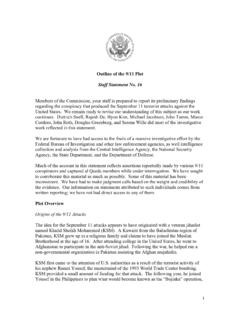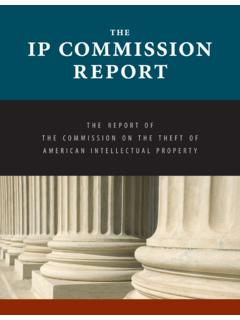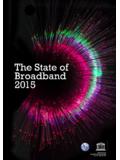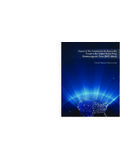Transcription of AND TERRORIST TRAVEL - 9-11commission.gov
1 AND. TERRORIST . TRAVEL . Staff report of the National commission on TERRORIST Attacks Upon the United States 9/11 AND. TERRORIST TRAVEL . Staff report of the National commission on TERRORIST Attacks Upon the United States By Thomas R. Eldridge Susan Ginsburg Walter T. Hempel II. Janice L. Kephart Kelly Moore and Joanne M. Accolla, Staff Assistant Alice Falk, Editor Note from the Executive Director The commission staff organized its work around specialized studies, or monographs, prepared by each of the teams. We used some of the evolving draft material for these studies in preparing the seventeen staff statements delivered in conjunction with the commission 's 2004 public hearings. We used more of this material in preparing draft sections of the commission 's final report . Some of the specialized staff work, while not appropriate for inclusion in the report , nonetheless offered substantial information or analysis that was not well represented in the commission 's report .
2 In a few cases this supplemental work could be prepared to a publishable standard, either in an unclassified or classified form, before the commission expired. This study is on immigration, border security and TERRORIST TRAVEL issues. It was prepared principally by Thomas Eldridge, Susan Ginsburg, Walter T. Hempel II, Janice Kephart, and Kelly Moore, with assistance from Joanne Accolla, and editing assistance from Alice Falk. As in all staff studies, they often relied on work done by their colleagues. This is a study by commission staff. While the Commissioners have been briefed on the work and have had the opportunity to review earlier drafts of some of this work, they have not approved this text and it does not necessarily reflect their views. Philip Zelikow 9/11 and TERRORIST TRAVEL Staff report , August 21, 2004. Table of Contents Note from the Executive Director List of Illustrations Preface 1. Introduction: A Factual Overview of the September 11 Border Story 2.
3 The September 11 TRAVEL Operation a Chronology 3. TERRORIST Entry and Embedding Tactics, 1993-2001. The Redbook TERRORIST TRAVEL Tactics by Plot Al Qaeda's Organizational Structure for TRAVEL and TRAVEL Tactics 4. Immigration and Border Security Evolve, 1993 to 2001. The Intelligence Community The State Department The Immigration and Naturalization Service 5. Planning and Executing Entry for the 9/11 Plot The State Department The Immigration and Naturalization Service Finding a Fair Verdict 6. Crisis Management and Response Post-September 11. The Intelligence Community The Department of State The Department of Justice Response at the Borders, 9/11-9/20, 2001. The Department of Homeland Security Appendix A: Graphics Appendix B: The Saudi Flights Appendix C: Immigration Histories of Certain Individuals with TERRORIST Connections List of Illustrations In Appendix A: x Mohamed Atta's visa x Ramzi Binalshibh's visa application x Ziad Jarrah's charred visa recovered in Somerset County, Penn.
4 X Hani Hanjour's visa application x Marwan al Shehhi's application to change his immigration status x Mohand al Shehri's visa application x Ahmad al Haznawi's visa application x Saeed al Ghamdi's visa application x Ahmed al Nami's visa application x Mohamed Atta's revised immigration arrival record x Handwritten notes of immigration official re: Atta's record x Mohamed Atta's Florida state driver's license x Saeed al Ghamdi's Immigration arrival record x Saeed al Ghamdi's Customs declaration x Salem al Hazmi's USAID identification card x Khalid al Mihdhar's USAID identification card x Khalid Sheikh Mohammed's alias visa application x Ahmed al Ghamdi's state of Virginia identification card photo Preface It is perhaps obvious to state that terrorists cannot plan and carry out attacks in the United States if they are unable to enter the country. Yet prior to September 11, while there were efforts to enhance border security, no agency of the government thought of border security as a tool in the counterterrorism arsenal.
5 Indeed, even after 19 hijackers demonstrated the relative ease of obtaining a visa and gaining admission into the United States, border security still is not considered a cornerstone of national security policy. We believe, for reasons we discuss in the following pages, that it must be made one. Congress gave the commission the mandate to study, evaluate, and report on immigration, nonimmigrant visas and border security as these areas relate to the events of 9/11. This staff report represents 14 months of such research. It is based on thousands of pages of documents we reviewed from the State Department, the Immigration and Naturalization Service, the Department of Homeland Security, the Department of Justice, the Federal Bureau of Investigation, the Central Intelligence Agency, the Department of Defense, approximately 25 briefings on various border security topics, and more than 200. interviews. We are grateful to all who assisted and supported us along the way. The story begins with A Factual Overview of the September 11 Border Story.
6 This introduction summarizes many of the key facts of the hijackers' entry into the United States. In it, we endeavor to dispel the myth that their entry into the United States was clean and legal. It was not. Three hijackers carried passports with indicators of Islamic extremism linked to al Qaeda; two others carried passports manipulated in a fraudulent manner. It is likely that several more hijackers carried passports with similar fraudulent manipulation. Two hijackers lied on their visa applications. Once in the United States, two hijackers violated the terms of their visas. One overstayed his visa. And all but one obtained some form of state identification. We know that six of the hijackers used these state issued identifications to check in for their flights on September 11. Three of them were fraudulently obtained. The chronology that follows in chapter 2, The September 11 TRAVEL Operation, is a detailed account of how each hijacker acquired a visa and entered the United States.
7 In all, they had 25 contacts with consular officers and 43 contacts with immigration and customs authorities. They began acquiring their visas in April 1999 and began entering the country in December 2000. They successfully entered the United States 33 times over 21 months, through nine airports of entry, most of which were on the East Coast. Neither the consular officers who adjudicated their visas nor the immigration inspectors who admitted them into the country had any knowledge of fraudulent al Qaeda documents. The next chapter, TERRORIST Entry and Embedding Tactics, 1993 to 2001, explores the topic of fraudulent documents, which terrorists have long used to support their international TRAVEL . Indeed, the CIA studied these documents and published their commonalities as far back as the 1980s. They even made a training video for border inspectors to help them detect such fraud. This effort was abandoned in the early 1990s, just as the United States experienced the first attack on the World Trade Center in 1993.
8 We reviewed information available on TERRORIST TRAVEL practices in the 1990s and identified numerous entry and embedding tactics, unknown at the time of these earlier attacks in the United States owing to the lack of analysis. No government agency systematically would analyze terrorists' TRAVEL patterns until after 9/11, thus missing critical opportunities to disrupt their plans. Chapter 4, Immigration and Border Security Evolve, 1993 to 2001, provides an overview of counterterrorism activities as they relate to border security in the Intelligence Community, the State Department, and the Immigration and Naturalization Service. Here we explore the evolution of the TERRORIST watchlist and explain the process of applying for a visa and for gaining entry into the United States. The reader is introduced to the Bureau of Consular Affairs in the State Department and visa policy in general. The various INS. units working on counterterrorism are discussed, along with enforcement of immigration law and the immigration benefits system.
9 Chapter 5, Planning and Executing Entry for the 9/11 Plot, discusses visa issuance and admission into the United States as it specifically applied to the hijackers. Thus, visa policy in Berlin, the United Arab Emirates, and Saudi Arabia, where the hijackers received their visas, is explored in depth. Similarly, we review aspects of the admission of the hijackers in detail, noting the immigration violations they committed. On both topics, visas and entry, we include excerpts of interviews with consular, immigration, and customs officials involved in the admission of the hijackers. We conclude with an assessment of how well the State Department and the INS performed in the period prior to 9/11. Crisis Management and Response Post September 11, chapter 6, reports on actions taken by the intelligence community, the departments of State and Justice, and the INS. following the attacks, up to the establishment of the Department of Homeland Security. Particular attention is paid to programs implemented by the Justice Department, in some cases as part of the interagency process, including the Interview Project, Visa Condor, the Absconder Apprehension Initiative, and NSEERS, the National Security Exit and Entry Registration System.
10 Appendix A contains graphics relevant to the 9/11 plot. In Appendix B, The Saudi Flights, we examine the facts and circumstances surrounding the departure of Saudi nationals from the United States in the days after the 9/11 attack. The procedure followed for each flight, including the inspection of passengers and their belongings, is covered in detail. Finally, in Appendix C, we describe the immigration histories of certain terrorists. 1. 1. Introduction: Factual Overview of the September 11 Border Story Terrorists TRAVEL for many reasons, including to train, communicate with other terrorists, collect funds, escape capture and interrogation, engage in surveillance of potential targets, and commit TERRORIST To avoid detection of their activities and objectives while engaging in TRAVEL that necessitates using a passport, terrorists devote extensive resources to acquiring and manipulating passports, entry and exit stamps, and visas. The al Qaeda TERRORIST organization was no exception.








